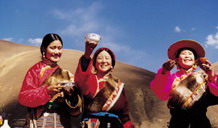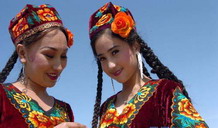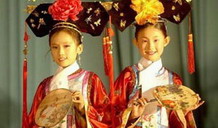History and Folk Culture of the Mongolians
Mongolians live mainly in the Inner Mongolia Autonomous Region though some are distributed in Xinjiang, Liaoning, Jilin, Heilongjiang, Gansu and Qinghai provinces. Others are scattered in Sichuan, Ningxia, Yunnan and Beijing.
Mongolians have their own spoken and written language, belonging to the Mongolian Austronesian of the Altaic Phylum. The Mongolians have three dialects: Inner Mongolian, Barag-Buryat and Uirad. The Mongolian script was created in the early 13th century on the basis of the Huihu script, which was revised and developed into the form now used.
Mongolians have been nomadic for centuries. "Mongolian" originally was the name of one of the Mongolian tribes roaming along the Erguna River. At the beginning of the 13th century, a Mongolian tribe headed by Genghis Khan unified all the Mongolian tribes, giving birth to a new people -- the Mongolian ethnic minority. In 1206, he was elected the Great Khan of all Mongols with the title of Genghis Khan. Kublai Khan, the grandson of Genghis Khan, founded the Yuan Dynasty (1206-1368) in 1272, and subdued the Southern Song (1127-1279) in 1279, bringing the whole of China under his centralized rule.
Living on the grasslands, Mongolians rely on raising stock as an economic mainstay. Kumiss and roasted mutton are their favorite food and drink. Nowadays, they are also engaged in agriculture and industry.
Mongolian script was created in the 13th century and later produced many historical and literary works, including the "Inside History of Mongolia," which has been listed as a World Cultural Heritage item in China by the UNESCO. Great works of folk literature include the "Life Story of Jianggar," an epic of the 15th century. Mongolian medicine is best known for its Lamaist therapy, which is most effective for traumatic surgery and the setting of fractured bones.
Mongolians believed in shamanism in ancient times. The red sect of Lamaism began to find its followers among the Mongolian rulers in the 13th century. In the 16th century, many feudal lords as well as herdsmen shifted to the yellow sect. Lamaism was later protected and encouraged by the imperial court of the Qing Dynasty.
Mongolians practice monogamy. Before the mid-20th century, intermarriage between nobles and common people was permitted, except that daughters of Zhasake lords were not allowed to marry common people. Marriage was generally arranged by parents, or local feudal lords as in the case of the western grasslands, with costly betrothal gifts demanded. Before weddings, Buddhist scriptures would be chanted and heavenly protection sought.






